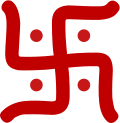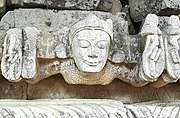Pragjyotisha Kingdom
Pragjyotisha was a mythological kingdom that later came to be associated with the historical Kamarupa.[1]
Pragjyotisha Kingdom | |
|---|---|
_LACMA_M.72.3.1.jpg) A scene involving king Naraka | |
| Capital | Pragjyotishpura |
| Government | Absolute monarchy |
| Historical era | Vedic period |
| Today part of | |
| Part of a series on |
| Hindu mythology |
|---|
 |
| Sources |
| Cosmology |
| Deities |
| Personalities of the Epics |
| Hinduism Portal |
| Part of a series on the | ||||||||
| Mythology of Pragjyotisha | ||||||||
|---|---|---|---|---|---|---|---|---|
 | ||||||||
| Ruling dynasties | ||||||||
|
||||||||
| Part of a series on the |
| History of Assam |
|---|
 |
|
Proto-historic |
|
Late Medieval |
|
Modern |
|
Contemporary |
| Categories |
|
The first mentions of this kingdom are found in the Ramayana and the Mahabharata, in the sections not written much earlier than the first century.[2] In the Kishkindha Kanda of the Ramayana, the kingdom is placed in the west near Mount Varaha on the sea.[3] In Aswamedha-parvan of the Mahabharata, Arjuna faced Vajradatta of Pragjyotisha.[4]
The ancient kingdom was preceded by Danava dynasty and was contemporary of Bana dynasty of Sonitpura (central Assam).[5] It is indiscriminately mentioned in the Hindu Epics and ancient Hindu literature.[6]
History
According to the epics, King Bhagadatta ruled the kingdom during the time of the Kurukshetra War, where he met his death.[7] Much details of the kingdom is culled from the Ramayana, Mahabharata, Kalika Purana and the later Yogini Tantra among others.
References in Mahabharata
- Arjuna defeats Bhagadatta, the king of Pragjyotisha, during his military campaign to collect tribute for Pandava king Yudhishthira's Rajasuya sacrifice (2,26)
- An encounter took place between Bhagadatta and Arjuna for days together each desirous of victory over the other. Then Bhagadatta, who regarded Indra as his friend, made friendship with Arjuna. (5,168)
- King Bhagadatta of Pragjyotisha accompanied by all Mlechcha tribes inhabiting the marshy regions on the sea-shore; and many mountain kings came to attend Yudhishthira's Rajasuya sacrifice (2,33).
- The great warrior king Bhagadatta, the brave ruler of Pragjyotisha and the mighty sovereign of the mlechchas, at the head of a large number of Yavanas came to the Rajasuya sacrifice (2,50)
- Bhagadatta was one of the main great Chariot warrior (Maharathi) in the Kaurava army for the Kurukshetra War (5,55)
- The ruler of Pragjyotisha, the brave Bhagadatta is the foremost of those holding the elephant hook (skilled in fighting from the neck of a war-elephant) and is skilled also in fighting from a car. (5,168)
- Bhagadatta, the Pragyotisha king, fought in Kurukshetra War as a general under the Kaurava generallisimo Bhishma(6-65,75,82,84,96,112,114,115,117). He also fought under Drona another Kaurava generalissimo. (7-20,24,25,26,27). He was slain by Arjun (7,27).
- After the Kurukshetra War, Arjuna fought a war with Bhagadatta's son Vajradatta, at Pragjyotisha, to collect tribute for Yudhishthira's Ashwamedha sacrifice. (14,75)
- By destroying the Mauravas and the Pashas, and slaying Nisunda and Naraka, Vasudeva Krishna hast again rendered safe the road to Pragjyotisha. (3,12)
- The Asuras had a city named Pragjyotisha, which was formidable, inaccessible and impregnable. It was there that the mighty Naraka, the son of the Earth (Bhumi), kept the jewelled ear-rings of Aditi, having brought them by force. Aditi's sons (the Devas) were unable to recover them. Beholding Krishna's prowess and might, and weapon that is irresistible they employed him for the destruction of those Asuras. Krishna agreed to undertake that exceedingly difficult task. In the city of Nirmochana that hero slew six thousand Asuras, and cutting into pieces innumerable keen-edged shafts, he slew Mura and hosts of Rakshasas, and then entered that city called Pragjyotisha. It was there, that an encounter took place between the mighty’ Naraka and Krishna. Slain by Krishna, Naraka lay lifeless there. Having slain the Earth's son (Bhumi-putra or Bhauma), Naraka and also Mura, and having recovered those jewelled ear-rings, Krishna came back, adorned with undying fame. (5,48). Mentioned also at (12,339)
- When Krishna went to Pragjyotisha, Naraka with all the Danavas did not succeed in seizing him there. (5,130)
- Vasudeva Krishna mentions that when he and his army was at Pragjyotisha, fighting there, Chedi king Shishupala, Krishna's cousin and enemy, came and burnt Dwaraka, the capital of Yadavas, in which Vasudeva Krishna belonged. (2,44)
- Salwa kings car of precious metals capable of going anywhere at will, bewildering all, reappeared at Pragjyotisha! (3,22)
See also
- Mahabharata war
- Sonitpura Kingdom
- Kingdoms of Ancient India
Notes
- Mukunda Madhava Sharma (1978),Inscriptions of Ancient Assam, p.221, p.p.366, Department of Publication, Gauhati University
- "...the passages in questions may not be much earlier than the first century." (Sircar 1990, p. 81)
- (Sircar 1990, p. 81)
- (Sircar 1990, p. 81)
- Hasmukhlal Dhirajlal Sankalia, Bhaskar Chatterjee, Rabin Dev Choudhury (1989), History and archaeology: Prof. H.D. Sankalia felicitation volume, p.59, p.p 416, Ramanand Vidya Bhawan
- S. Sasanananda (1986), History of Buddhism in Assam, c. 300 B.C.-1200 A.D, p.6, p.p.264, Bahri Publications
- Suniti Kumar Chatterji (1970), The Place of Assam in the History and Civilisation of India, p.15, p.p.83, Department of Publication, University of Gauhati
References
- Sircar, D C (1990), "Epico-Puranic Myths and Allied Legends", in Barpujari, H K (ed.), The Comprehensive History of Assam, I, Guwahati: Publication Board, Assam, pp. 79–93CS1 maint: ref=harv (link)
Further reading
- Mahabharata of Krishna Dwaipayana Vyasa (English translation by Kisari Mohan Ganguli)